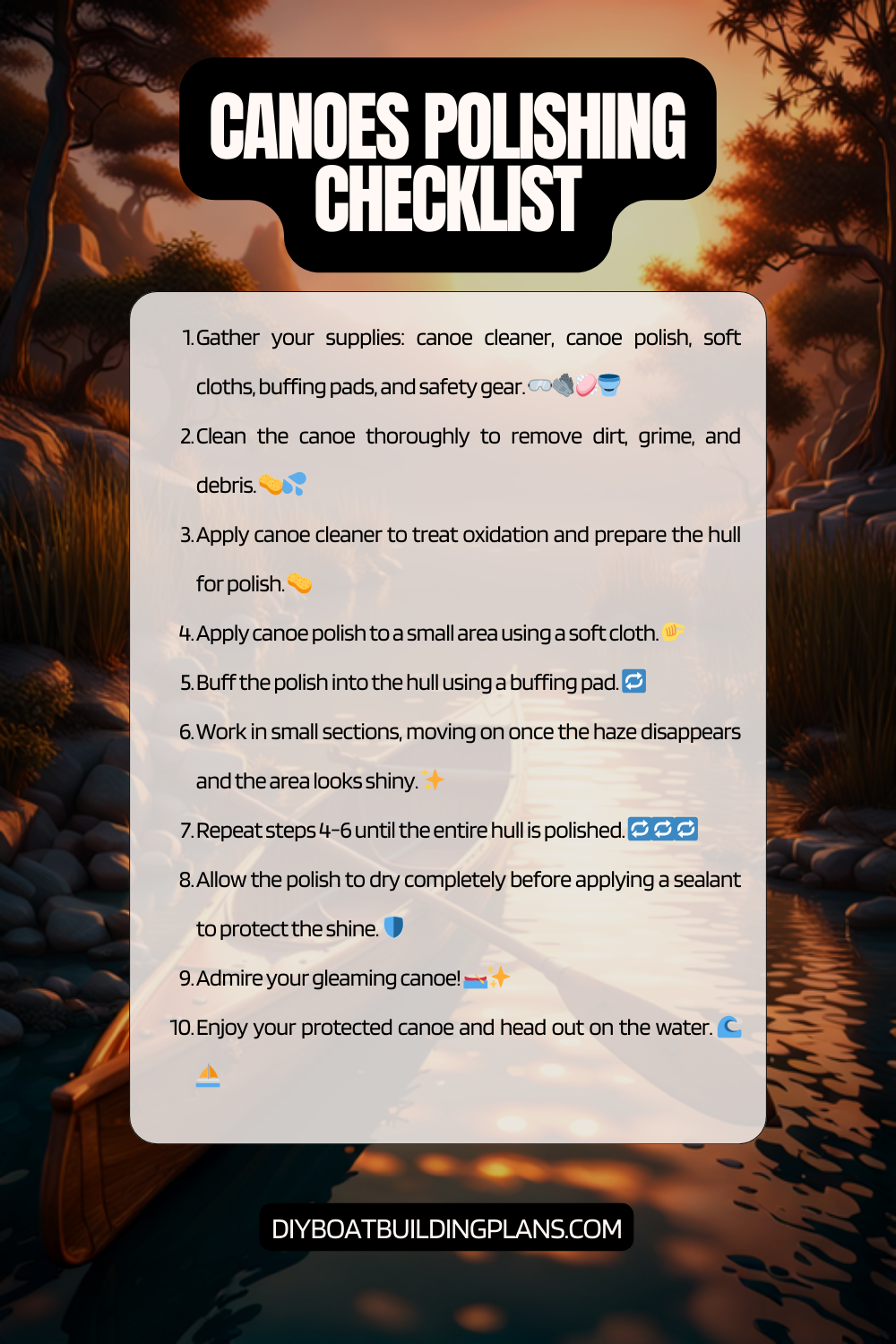Overview of Canoe Polishing Tips
Canoe polishing is the process of restoring and maintaining the appearance of a canoe. It involves applying a polish or wax to the exterior surface of the canoe to protect it from environmental damage, improve its performance, and enhance its overall appearance. Canoes are often exposed to harsh elements such as sunlight, water, and dirt, which can cause the paint or finish to fade or deteriorate over time. By regularly polishing your canoe, you can not only extend its lifespan but also ensure that it looks its best on every outing.
Key Takeaways
- Canoe polishing is important for maintaining the appearance and longevity of your canoe.
- Choosing the right polishing products and preparing the canoe properly are crucial steps in the process.
- Applying the polish and buffing the canoe for a smooth finish requires attention to detail.
- Dealing with scratches and dents can be challenging, but there are techniques to help.
- Regular maintenance is key to keeping your canoe looking its best, and different types of canoes may require different polishing techniques.

Importance of Canoe Polishing
One of the primary reasons for canoe polishing is to protect the canoe from environmental damage. Sunlight can cause the paint or finish on a canoe to fade or crack, while water can lead to corrosion or rotting in wooden canoes. By applying a protective polish or wax, you create a barrier between the canoe’s surface and these harmful elements, preventing damage and preserving its structural integrity.
In addition to protection, canoe polishing also improves the performance of the canoe. A smooth and polished surface reduces drag in the water, allowing for better maneuverability and speed. This is especially important for competitive paddlers who rely on their canoes for racing or other water sports. By regularly polishing your canoe, you can ensure that it glides effortlessly through the water, giving you a competitive edge.
Furthermore, canoe polishing enhances the overall appearance of the canoe. A well-maintained and polished canoe not only looks more appealing but also reflects your pride in ownership. Whether you use your canoe for recreational purposes or professional competitions, having a sleek and shiny exterior adds to the overall experience and enjoyment of using your canoe.
Choosing the Right Polishing Products
When it comes to choosing the right polishing products for your canoe, there are several options available in the market. The choice depends on factors such as the type of material your canoe is made of, personal preference, and the level of protection and shine you desire.
For fiberglass canoes, a fiberglass polish or wax is recommended. These products are specifically formulated to protect and enhance the appearance of fiberglass surfaces. They provide a long-lasting shine and help to repel water, preventing damage from moisture.
For aluminum canoes, an aluminum polish is ideal. These polishes are designed to remove oxidation and restore the shine to aluminum surfaces. They also provide a protective layer that helps prevent further oxidation and corrosion.
For wooden canoes, a wood polish or wax is recommended. These products nourish the wood, enhance its natural beauty, and protect it from moisture and UV damage. It is important to choose a polish that is specifically formulated for use on wood to avoid any potential damage.
When choosing a polishing product, consider factors such as ease of application, durability, and environmental impact. Look for products that are easy to apply and buff, provide long-lasting protection, and are environmentally friendly.
Preparing the Canoe for Polishing
| Task | Time Required | Materials Needed | Tools Needed |
|---|---|---|---|
| Clean the Canoe | 30 minutes | Soap, Water, Sponge | None |
| Sand the Canoe | 2 hours | Sandpaper (80, 120, 220 grit) | Sanding Block |
| Apply Wood Filler | 1 hour | Wood Filler, Putty Knife | None |
| Sand the Filler | 30 minutes | Sandpaper (220 grit) | Sanding Block |
| Apply Stain | 1 hour | Wood Stain, Brush | None |
| Apply Varnish | 2 hours | Marine Varnish, Brush | None |
Before applying polish to your canoe, it is important to properly clean the surface to remove any dirt, grime, or existing wax or polish. Start by rinsing the canoe with water to remove loose debris. Then, use a mild detergent or boat soap and a soft sponge or brush to scrub the surface gently. Pay attention to areas that are prone to dirt buildup, such as the bottom of the canoe or around the gunwales.
After cleaning, rinse the canoe thoroughly with water to remove any soap residue. Allow it to dry completely before proceeding with the polishing process. It is important to ensure that the canoe is completely dry as any moisture can interfere with the adhesion of the polish or wax.
If there is any existing wax or polish on the canoe’s surface, it needs to be removed before applying a new coat. This can be done using a wax remover or a mixture of vinegar and water. Apply the wax remover or vinegar solution to a clean cloth and gently rub it onto the surface in circular motions. This will help dissolve and remove the old wax or polish. Once the surface is clean, rinse it with water and dry it thoroughly.
Applying the Polish to the Canoe
To apply polish to your canoe, start by choosing a suitable applicator. Microfiber cloths or foam applicator pads are commonly used for this purpose as they provide even coverage and minimize the risk of scratching the surface.
Before applying the polish, shake the bottle well to ensure that the product is properly mixed. Then, pour a small amount of polish onto the applicator pad or cloth. Begin applying the polish to the canoe’s surface in small circular motions, working in sections to ensure even coverage.
Apply a thin and even coat of polish, avoiding excessive buildup or pooling. This will help prevent streaks or unevenness in the final finish. Continue applying polish until you have covered the entire surface of the canoe.
Once you have applied the polish, allow it to dry according to the manufacturer’s instructions. This usually takes a few minutes. During this time, avoid touching or disturbing the surface to prevent smudging or unevenness.
Buffing the Canoe for a Smooth Finish
After the polish has dried, it is time to buff the canoe for a smooth and shiny finish. Buffing helps to remove any excess polish and bring out the shine of the canoe’s surface.
To buff your canoe, use a clean microfiber cloth or a buffing pad attached to a buffer machine. Start by gently buffing the surface in circular motions, applying light pressure. This will help remove any residue and bring out the shine of the polish.
Continue buffing until you achieve a smooth and glossy finish. Pay attention to any areas that may require extra attention, such as scratches or dull spots. Buffing these areas more vigorously can help restore their appearance.
It is important to use the right tools for buffing to avoid causing any damage to the canoe’s surface. Microfiber cloths are gentle and effective for hand buffing, while buffing pads attached to a buffer machine provide more power and efficiency. Choose the method that suits your preference and the condition of your canoe.
Dealing with Scratches and Dents
Before polishing your canoe, it is important to address any scratches or dents on the surface. Polishing alone will not remove deep scratches or repair structural damage. However, minor scratches and dents can be addressed before polishing to achieve a smoother and more polished appearance.
To repair minor scratches, start by cleaning the affected area with water and a mild detergent. Then, use a fine-grit sandpaper or rubbing compound to gently sand the scratch in a circular motion. This will help smooth out the surface and reduce the visibility of the scratch.
For deeper scratches or dents, it may be necessary to use a filler or epoxy resin to fill in the damaged area. Follow the manufacturer’s instructions for applying the filler or resin, ensuring that it is properly mixed and applied evenly.
After repairing any scratches or dents, proceed with the polishing process as described earlier. Take care not to apply excessive pressure or buff aggressively over repaired areas to avoid causing further damage.
Maintaining the Polished Canoe
Once you have achieved a polished finish on your canoe, it is important to maintain its appearance to ensure long-lasting results. Regular maintenance will help preserve the shine and protect the canoe from environmental damage.
To maintain a polished canoe, start by rinsing it with water after each use to remove any dirt or saltwater residue. This will prevent buildup and potential damage to the polish or wax.
Periodically, clean the canoe using a mild detergent or boat soap and a soft sponge or brush. This will help remove any dirt or grime that may accumulate over time. Rinse the canoe thoroughly with water and dry it completely before applying a fresh coat of polish or wax.
The frequency of polishing depends on factors such as the type of polish used, the level of exposure to environmental elements, and personal preference. As a general guideline, it is recommended to polish your canoe at least once every season or every few months to maintain its appearance and protection.
Tips for Polishing Different Types of Canoes
Different types of canoes require specific polishing techniques and products to achieve the best results. Here are some tips for polishing aluminum, fiberglass, and wooden canoes:
– For aluminum canoes, start by cleaning the surface with a mild detergent or boat soap to remove any dirt or oxidation. Then, apply an aluminum polish using a clean cloth or applicator pad. Work in small sections, applying even pressure and buffing in circular motions. Once the polish has dried, buff the surface to achieve a smooth and shiny finish.
– Fiberglass canoes can be polished using a fiberglass polish or wax. Clean the surface thoroughly before applying the polish, ensuring that it is dry and free from any existing wax or polish. Apply the fiberglass polish using a clean cloth or applicator pad, working in small sections. Allow the polish to dry before buffing the surface for a smooth finish.
– Wooden canoes require special care when it comes to polishing. Start by cleaning the surface with a mild detergent or boat soap, taking care not to saturate the wood with water. Once the surface is dry, apply a wood polish or wax using a clean cloth or applicator pad. Work in small sections, following the direction of the wood grain. Allow the polish to dry before buffing the surface gently for a smooth and glossy finish.
Download over 500 Boat Plans. Click on the link below.
-->Click Here<--
Common Mistakes to Avoid while Polishing Canoes
While canoe polishing is a relatively straightforward process, there are some common mistakes that can be easily avoided. Here are a few to keep in mind:
– Applying too much polish: Excessive polish can lead to streaks, unevenness, or a sticky residue. It is important to apply a thin and even coat of polish to achieve the best results.
– Using the wrong tools: Using abrasive materials or tools that are not suitable for the canoe’s surface can cause scratches or damage. Always use soft and non-abrasive materials such as microfiber cloths or foam applicator pads.
– Neglecting to clean the surface properly: Failing to clean the canoe’s surface thoroughly before polishing can result in poor adhesion and an uneven finish. Take the time to clean and dry the surface properly before applying polish.
– Buffing too aggressively: Buffing too vigorously or using excessive pressure can cause swirl marks or scratches on the canoe’s surface. It is important to buff gently and evenly to achieve a smooth and glossy finish.
By avoiding these common mistakes, you can ensure that your canoe polishing efforts yield the best possible results.
Canoe Polishing Checklist

Conclusion – Canoe Polishing Tips
In conclusion, canoe polishing is an important aspect of maintaining the appearance and performance of your canoe. By regularly polishing your canoe, you can protect it from environmental damage, improve its performance on the water, and enhance its overall appearance.
When choosing polishing products, consider factors such as the type of material your canoe is made of and the level of protection and shine you desire. Prepare your canoe for polishing by cleaning it thoroughly and removing any existing wax or polish. Apply the polish in thin and even coats, allowing it to dry before buffing for a smooth finish.
Take care of any scratches or dents before polishing to achieve the best results. Maintain your polished canoe by rinsing it after each use and periodically cleaning it with a mild detergent or boat soap. Polish your canoe regularly to maintain its appearance and protection.
By following these tips and avoiding common mistakes, you can achieve a polished canoe that not only looks great but also performs at its best on every adventure. So, grab your polishing products and get ready to make your canoe shine!
FAQs – Canoe Polishing Tips
What is canoe polishing?
Canoe polishing is the process of cleaning and shining the exterior of a canoe to maintain its appearance and protect it from damage caused by exposure to the elements.
Why is canoe polishing important?
Canoe polishing is important because it helps to protect the canoe from damage caused by exposure to the elements, such as UV rays, water, and dirt. It also helps to maintain the appearance of the canoe, making it look new and shiny.
What materials are needed for canoe polishing?
Materials needed for canoe polishing include a cleaning solution, a polishing compound, a soft cloth or sponge, and a wax or sealant.
What is the best way to clean a canoe before polishing?
The best way to clean a canoe before polishing is to use a mild cleaning solution and a soft cloth or sponge. Avoid using harsh chemicals or abrasive materials that can damage the canoe’s surface.
What is the best way to apply a polishing compound?
The best way to apply a polishing compound is to use a soft cloth or sponge and apply the compound in a circular motion. Work in small sections and apply the compound evenly.
What is the best way to apply wax or sealant?
The best way to apply wax or sealant is to use a soft cloth or sponge and apply the wax or sealant in a thin, even layer. Allow the wax or sealant to dry completely before buffing it off with a clean cloth.
How often should a canoe be polished?
The frequency of canoe polishing depends on how often the canoe is used and how it is stored. Generally, it is recommended to polish a canoe at least once a year to maintain its appearance and protect it from damage.



